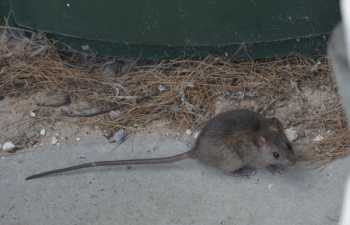Penguin Island, only 700 m from the shore of Western Australia south of Fremantle is 12.5 ha in size. As well as a declining population of some 1200 pairs of Little Penguins Eudyptula minor the island supports breeding colonies of Little Shearwaters Puffinus assimilis, White-faced Storm Petrels Pelagodroma marina and other seabirds. Penguin Island falls within the Shoalwater Islands Marine Park.
Black or Ship Rats Rattus rattus began to appear on the island about a year ago and have led to a decrease in penguin breeding success. It is thought they either crossed the sandbar to the island at low tide or stowed away on a visiting boat.

Black Rat on Penguin Island.
Photograph courtesy of the Western Australian Department of Environment and Conservation
The Western Australian Department of Environment and Conservation is commencing ground-baiting with an anticoagulant poison today and expects the island to be rat-free by the end of February. Rat poison will be contained in 270 bait stations and placed in a grid pattern around the island for six weeks. A reduction in the introduced House Mouse Mus musculus population is expected (click here).
A biosecurity plan is to be developed and implemented to ensure Black Rats and other introduced animals and plants are not taken to Penguin Island in the future.
Click here for a management plan for the island and marine park. The island is open to tourism and will remain open during the baiting operation although the public will be restricted to the boardwalks, walk trails and main beaches so that the bait stations will not be readily accessible (click here).
See also http://au.news.yahoo.com/thewest/a/-/breaking/15788594/rat-plague-hits-penguins/.
The subspecies of Little Shearwater P. a. tunneyi that breeds on Western Australian islands is not considered domestically threatened. Globally the Little Shearwater is categorized as of Least Concern.
Reference:
Garnett, Stephen T., Szabo, Judit K. & Dutson, Guy 2011. The Action Plan for Australian Birds. Collingwood: CSIRO Publishing. 442 pp. ISBN 9780643103689.
John Cooper, ACAP Information Officer, 13 January 2013

 English
English  Français
Français  Español
Español